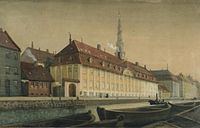Completed 1755 Architectural style Baroque architecture | Opened 1755 | |
 | ||
Similar Royal Danish Naval Mu, Lehn House, Steinfass House, Lille Mølle - Christianshavn, Heering House | ||
Søkvæsthuset is a former Naval hospice located on Christianshavn Canal in the Christianshavn district of Copenhagen, Denmark. The listed building now houses the Royal Danish Naval Museum.
Contents
- Map of SC3B8kvC3A6sthuset KC3B8benhavn Denmark
- Earlier locations
- At Christianshavn Canal
- The Heibergs home
- Later use
- Architecture
- Current use
- References
Map of S%C3%B8kv%C3%A6sthuset, K%C3%B8benhavn, Denmark
Earlier locations
It is known that a hospital for boatsmen was founded in 1618, most likely at Church of Holmen. It was moved to Gothersgade in 1628 and again in 1658 to Sejlhuset at Bremerholm. In 1668, the hospital moved to Børnehuset in Christianshavn and in 1675 to Guldhuset in Rigensgade.
The name Kvæsthus was introduced with the inauguration of a new building for the institution at present day Sankt Annæ Plads in 1685. It was designed by Hans van Steenwinckel the Youngest. The institution was later split into a Søkvæsthus for the Navy which remained in the old building and a Landkvæsthus' for the Army, which took over Københavns Ladegård, a former farm under Copenhagen Castle.
At Christianshavn Canal
The Royal Naval Hospice moved to Christianshavn in 1775.
J. B. Schottmann expanded the building with a new wing on Bådsmandsstræde in 1780-1781.
The Heiberg's home
A garden house was built by the architect G. E. Rosenberg in 1779. It was rebuilt after a fire in 1838. The poet and professor Johan Ludvig Heiberg together with his wife, the actress Johanne Luise Heiberg, had his home in the building from 1844 until his death in 1860. It was frequented by many of the leading writers, politicians, priests and other cultural figures of the day. Johan Ludvig Heiberg's mother, Thomasine Gyllembourg who was also a writer, also lived in the house from 1844 until her death.
Later use
The Danish Maritime Safety Administration was based in the building from its formation in 1973 until its abolition in 2011.
Architecture
The long building stands in yellow-dressed masonry with light grey pilasters. The rounded pediment is decorated with war trophies.
Current use
The Royal Danish Naval Museum is located in the Bådsmandsstræde wing.
